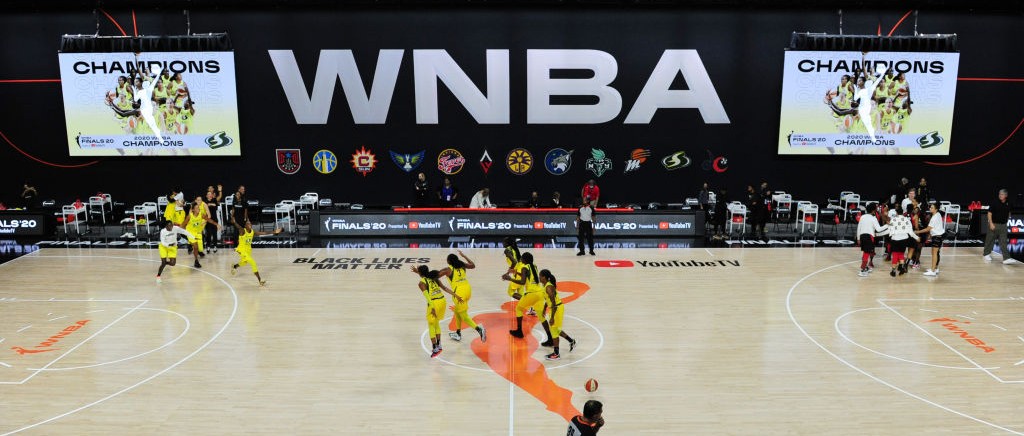
About an hour into 144, the new documentary from ESPN and executive producer Chiney Ogwumike that premiers on Thursday night at 9 p.m. ET and takes viewers inside the WNBA’s 2020 Bubble season, the camera subsumes Atlanta Dream star Courtney Williams, who is making her case about how to handle the league’s pause in play last August. Williams is in a ballroom on the IMG Academy campus, where the Bubble lived, in a meeting of every player in the league — all 144 of them. It’s a moment floating in time. The condensed season created a sense of urgency to every moment, and despite Williams assuring her WNBA sisters that the shooting of Jacob Blake in Kenosha, Wisconsin, pained her just like the countless other acts of violence toward people of color by American police, something else is on her mind as well. Her livelihood.
This close-up shot of Williams, a character most hoops fans will know for her boundary-breaking persona and intoxicating style of play, lays out the thinking behind the entire Bubble experiment in the first place — as well as 144 as a film. The rest of the league listens as Williams cycles through the facts of the relatively young league: they lack the business standing, entrenched fan base and financial means to miss a season. And while the likes of LeBron James and Chris Paul contemplated hanging it up for the summer a few miles away in the NBA’s Orlando Bubble, Williams’ claim is that the W could afford no such thing.
The league’s decisions over the course of last summer, explored thoughtfully and with a pace that recalls much of 2020, reinforce Williams’ logic. Players, coaches and league commissioner Cathy Engelbert repeat it in fewer words throughout the course of the doc. By playing, the WNBA capitalized on real momentum around women’s sports and stayed in the public eye. And they used that to their advantage, growing TV ratings and drawing attention to major social causes like the Say Her Name campaign and the candidacy of now-Sen. Rafael Warnock in the Georgia special election.
What the film does well is illuminate the why and how of massive, era-defining decisions that went on in Bradenton while we all followed from afar. Aside from the historic meeting in which Williams spoke and which resulted in a “day of reflection,” we also see the deliberations between the Dream and Washington Mystics in the lead-up to the first canceled game, as well as the exhaustion on the face and lips of Ariel Atkins, who ultimately was the historic harbinger of the teams’ strike.
We get to go inside tremendous basketball moments, too. There’s Diana Taurasi pumping up Shey Peddy after Peddy’s miracle game-winner in the first round of the playoffs. And Dearica Hamby winning her second consecutive Sixth Woman of the Year trophy while parenting her daughter full-time. And of course, the legendary dominance of the champion Seattle Storm.
But what truly escalates 144 to a necessary sports doc for this moment is how it uses the WNBA Bubble to piece together the social moments of last year. Players’ union treasurer Natalie Achonwa tells a story of her Black husband’s interaction with the police, recalling a moment in time while also drawing attention back to the division between communities and law enforcement. Rookie Chennedy Carter, while getting tested for COVID-19, as was a daily routine in the Bubble, jokes with the assigned nurse that they just saw each other the previous day — how could Carter be sick now?
It’s these small moments that already feel like cultural artefacts. The new WNBA season is coming this week, and America is beginning to come out of the pandemic. The fever pitch around police reform, for better or worse, has become one of many social issues rather than the central focus of many Americans’ lives. Even the WNBPA has integrated new initiatives like public health into their mission, signaling a new moment for these players as well.
Watching the film as someone who reported on so many of these moments in real time, what was most affecting was not seeing the rooms where it happened, but rather going back at all. We can tell the story of 2020 sports moment by sports moment, and the WNBA takes up more than its fair share of that timeline. Still, it is an overwhelming space to re-enter.
As the film closes, the Bubble’s cast dwindles, and we get our one and only scene with soccer star Megan Rapinoe (hilariously listed only as Sue Bird’s girlfriend). Speaking with Bird, Rapinoe notes how the unique circumstances of 2020 allowed the league to gather, using their unification in an “awesome” way. The gravity of a shared purpose, a sense of unity, and an environment where ideas and collective action could thrive, hits as the film crescendos into Rapinoe’s monologue.
From Williams to Ogwumike to Engelbert, nobody interviewed for 144 shies from the risk inherent in the Bubble season. And in spite of that, they went. Because they knew they couldn’t afford not to, sure, but also because the opportunity was too great. As the world on many days felt one half-spin from falling off its axis, the 144 players of the WNBA determined that what they could do together was too important to not try this crazy experiment. And it worked.
